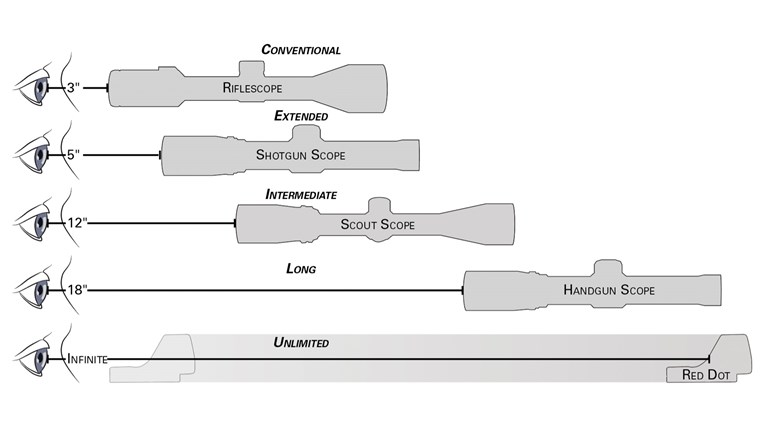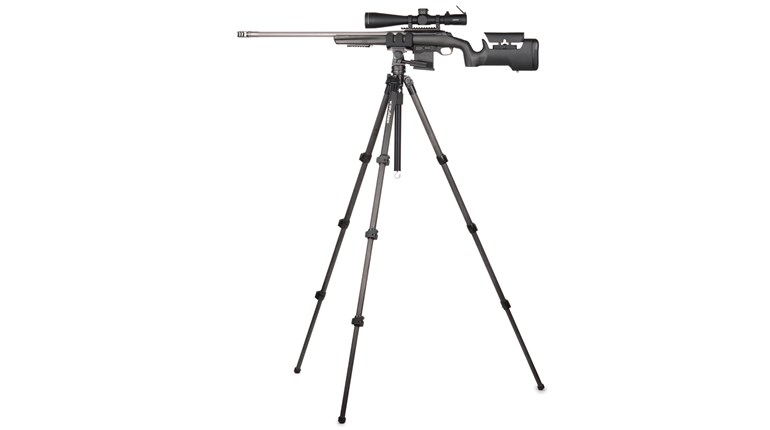
Don’t discount scout-style riflescopes, as the long eye relief in that design might be what you need in an optic that will work well for variable distances.
Between magnified riflescopes, electro-optics and plain ol’ iron sights, today’s rifle shooters can pretty much take care of everything from the muzzle to several thousand yards (or meters) away. Picking one setup for a narrow range of distances is no problem, but it gets trickier when you need to skin several cats at once. A prime example is when the ability to quickly connect with close or fleeting targets is as important as maintaining precision capability farther downrange.
We typically take care of this problem in one of three ways: a conventionally styled, low-power, variable optic (LPVO), a reflex sight with a removable magnifier or a high-power, magnified optic used in conjunction with a close-range, offset sighting system. Each of these approaches has a proven track record in the woods, at ranges and on battlefields around the world, but each also has one or more Achilles’ heels.
Most magnified scopes have relatively short eye relief, ranging from about 3 to 5 inches, and tend to grow in cost, size and weight as power, quality and features increase. This applies to both LPVOs and higher-power riflescopes. Electro-optical “dot” sights are not exactly the best option for precision aiming when magnified, due in large part to the irregularity of their projected reticles. But, an often-overlooked alternative deals with each of these problems: the long-eye-relief (LER) riflescope.
Most of us became aware of these forward-mounted, fixed- and variable-power optics as one component of the scout-rifle concept championed by the late Col. Jeff Cooper. LER scopes have been around much longer, chiefly in the form of pistol scopes that were occasionally pressed into service on larger firearms.
By modern tactical standards, LER scopes do not appear impressive on paper. Reticle options are few, mostly non-illuminated, second focal plane (SFP) and with set parallax. The usual magnification range is 2 to 7 power, 1-inch tubes are common and knobs are typically capped. Objectives are small, with most models featuring something in the 28 to 32 mm range. Nonetheless, LER scopes bring to the table an ability to quickly acquire a target up close or accurately engage a target out to the mid ranges in one simple, affordable package.
In addition to being well-suited for placement in front of top ejecting actions, LER scopes tend to be lighter than most LPVOs. They are also in the same price class as entry-level 1-4X and 1-6X LPVOs, while bringing slightly higher magnification to the table. These scopes use etched reticles in the second (or rear) focal plane, making them easy to see and use at any power. The forward placement of LERs makes them very fast to acquire and track moving targets with, even at higher magnifications.
Unfortunately, fans of long-eye-relief optics have limited options from which to choose. At the time of this writing, variable 2-7X models from Vortex, Burris, Hi-Lux and Leapers are easy to find on the retail market. Eye relief ranges from about 9 inches up to 13 inches, depending on the model. Leupold offers a 1.5-4X Intermediate Eye Relief (IER) scope with 6 to 6.9 inches of relief, for mounting applications that fall between conventional and LER positions. Longer eye relief can be found in some handgun scopes, such as Burris’ 3-12x32 mm, with its whopping 19 inches at low power. It is important to ensure a pistol scope is rated for your rifle chambering before using it that way. Scout-scope weights average around 12 ounces with street pricing in the $150 to $400 range.
Mounting solutions for LER optics vary, based on firearm type. The full-length Picatinny rails found on modern semi-automatic and bolt-action rifles make things easy, but older rifle designs often require a receiver mount with rings positioned on an extended cantilever. Several companies offer different-size mounts, ranging from Primary Arms’ sub-$75, one-piece unit to Midwest Industries’ $189 QD model. Rail sections that mount forward of an action are also available for some older rifle types. The Mini Scout Mount from Amega Mounts is offered for everything from M1 Carbines to Mosin-Nagants for right around $100.
I recently scoped a 1960s vintage Remington 742 carbine in .308 Win. Normally, a first-focal-plane LPVO would be my top choice. But, this rifle’s conventional stock and 870-inspired receiver require a standard-eye-relief scope to hang farther back over the stock than I am comfortable with on a field rifle. Instead, I mounted a 23-year-old Burris 2-7X LER in an extended, cantilever mount. Back when LPVOs lacked most of today’s highly utilitarian features, this particular Burris rode atop the Army-issued and accurized M4 carbine I used for reconnaissance and sniper-spotting work. Its new home has turned out to be the perfect place for this no-frills, lightweight optic. It may not be the best scope for all needs, but in the right application, this hard-ridden LER riflescope will get the job done as long as I do my part.



































